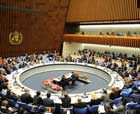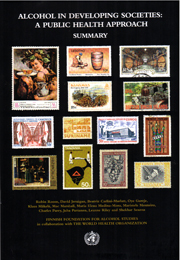
A well grounded Global Strategy to Reduce Harmful Use of Alcohol
The World Health Assembly, at its meeting in May, will have before it a Global Strategy to Reduce the Harmful Use of Alcohol.

The global strategy is a guide to understanding the problems of alcohol-related harm and a toolkit for addressing such problems at global, national and local level. It recognizes that alcohol-related harm is a public health problem not only affecting the drinker but includes harm to others. As a consequence its suggested strategies address alcohol consumption and drinking patterns at both population and individual level.
“We welcome the WHO global strategy. Although, due to our knowledge of the evidence base, sections of the strategy could be strengthened, making it more effective. However, we consider that the Strategy, if implemented, addresses issues that will be critical in public health efforts to reduce the toll of alcohol throughout the world”, says Global Alcohol Policy Alliance Chairman Derek Rutherford.
The strategy has five objectives:
- Raise global awareness of the magnitude and nature of the health, social and economic problems caused by harmful use of alcohol, and increased commitment by governments to act to address the harmful use of alcohol;
- Strengthen knowledge base on the magnitude and determinants of alcohol-related harm and on effective interventions to reduce and prevent such harm;
- Increase technical support to, and enhance capacity of, Member States for preventing the harmful use of alcohol and managing alcohol-use disorders and associated health conditions;
- Strengthen partnerships and better coordination among stakeholders and increased mobilization of resources required for appropriate and concerted action to prevent the harmful use of alcohol;
- Improve systems for monitoring and surveillance at different levels, and more effective dissemination and application of information for advocacy, policy development and evaluation purposes.
The Global Strategy recognizes that there are differences, cultural, social and economic, between countries and regions. Rather than presenting a one-size-fits-all solution the strategy therefore lists possible actions that have proven to be effective or promising. It is particularly interesting to see the emphasis placed on the reduction of availability to alcohol, both in terms of affordability and physical availability. This category of interventions has also been among the most controversial issues during the drafting process.
Rutherford explains that the global strategy has come as a part of a process that started when the alcohol issue, after more than 20 years on the periphery, moved to centre stage in global public health when in 2005 the World Health Assembly (WHA) passed the resolution, “Public health problems caused by harmful use of alcohol”. This was a result of evidence revealed in the Global Burden of Disease report. The report established that alcohol was a leading risk factor for premature death and disabilities.
In 2008 again the WHO member states asked for continued attention to the growing alcohol problems globally and passed a resolution asking WHO to draft a global strategy.
All relevant documents, including the draft Alcohol Strategy in six languages, can be found at the WHO web site.
Policy Options
The suggested interventions are grouped into ten target areas that should be seen as supportive and complementary for national action: -
- Leadership, awareness and commitment
- Health services’ response
- Community action
- Drink-driving policies and countermeasures
- Availability of alcohol
- Marketing of alcoholic beverages
- Pricing policies
- Reducing the negative consequences of drinking and alcohol intoxication
- Reducing the public health impact of illegal and informal alcohol
- Monitoring and surveillance
Restrictions on marketing
Section 29 of the Strategy addresses the question of how alcohol marketing can be regulated in oder to promote public health: "Reducing the impact of marketing, particularly on young people and adolescents, is an important consideration in reducing harmful use of alcohol. Alcohol is marketed through increasingly sophisticated advertising and promotion techniques, including linking alcohol brands to sports and cultural activities, sponsorships and product placements, and new marketing techniques such as e-mails, SMS and podcasting, social media and other communication techniques. The transmission of alcohol marketing messages across national borders and jurisdictions on channels such as satellite television and the Internet, and sponsorship of sports and cultural events is emerging as a serious concern in some countries."
Pricing policies
In section 32 the Stretegy recommends the use of pricing policies to influence the consumption of alcohol: "Consumers, including heavy drinkers and young people, are sensitive to changes in the price of drinks. Pricing policies can be used to reduce underage drinking, to halt progression towards drinking large volumes of alcohol and/or episodes of heavy drinking, and to influence consumers’ preferences. Increasing the price of alcoholic beverages is one of the most effective interventions to reduce harmful use of alcohol. A key factor for the success of price-related policies in reducing harmful use of alcohol is an effective and efficient system for taxation matched by adequate tax collection and enforcement."
Related articles
![]()
![]()
Developed with CustomPublish CMS by Nettinfo AS




